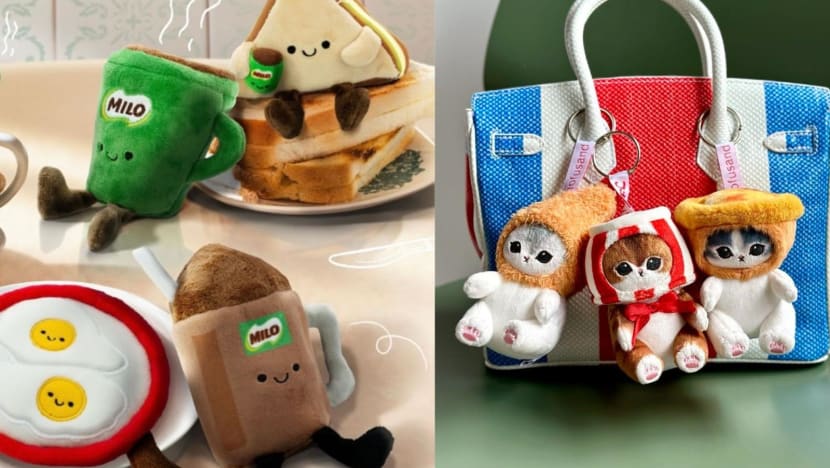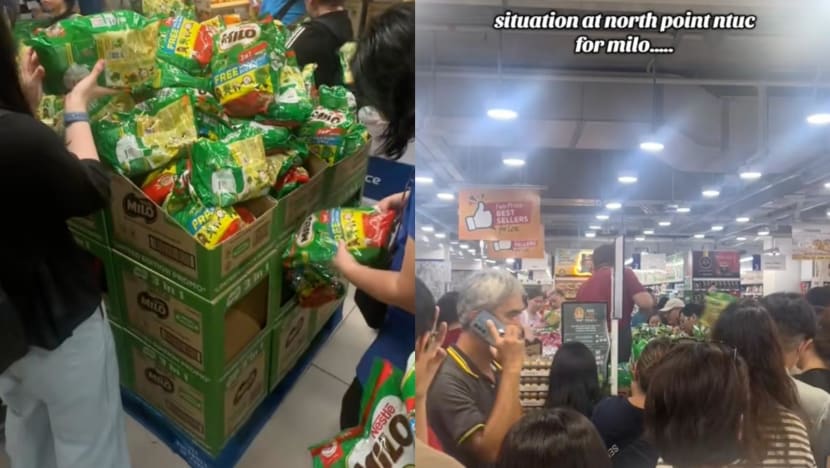Commentary: More brands are jumping on the ŌĆśkidultingŌĆÖ bandwagon. ItŌĆÖs not good news for us consumers
Before you scramble for the next limited-edition brand plushie, writer Annie Tan advises you to ask yourself: Will you still want it in a year?

Left: Limited-edition plushies of iconic local treats from Milo, launched Apr 26. Right: Limited-edition Mofusand plushies from KFC, launched in January. (Photo: Milo Singapore/Instagram, 8Days/Yip Jieying)

This audio is generated by an AI tool.
SINGAPORE: Who would have thought that your local Sheng Siong and FairPrice would become the new battleground for collectible plushies?┬Ā
On Apr 26, Milo launched of Milo drinks, kaya toast, soft-boiled eggs and gem biscuits in celebration of its 75th anniversary in Singapore.╠²Shoppers were seen crowding around Milo displays and hoarding the chocolate malt drink. Videos circulated online of people ŌĆ£massagingŌĆØ Milo packets to identify the hidden toy and unboxing their hauls. Scalpers listed the plushie on resale platforms like Carousell for as much as S$200.
Milo is not an outlier. Earlier this year, KFC launched . This week, Pizza Hut started offering a limited-edition cheeseburger melts-shaped plushie you can add to any Cheeseburger Melt order for S$6.90.╠²
With more food brands jumping on the collectible plush bandwagon, one question begs to be asked: why are we biting? Or rather, why are we scrambling for plushies shaped like everyday food ŌĆō Milo, kaya toast, eggs, burger melts ŌĆō when the actual food items rarely get a square on our social media feed? ┬Ā

FAST TOYS BY FAST BRANDS
You could say that few things galvanise Singaporeans like the words ŌĆ£freeŌĆØ and ŌĆ£while stocks lastŌĆØ. The zero-price effect and engineered scarcity triggers our FOMO like clockwork ŌĆō the fear of missing out on a good deal is arguably as Singaporean a trait as a love of good food.╠²
Truth be told, this is probably the main reason many of us continue to take our 15th free brand-labelled cooler box, Tupperware or tote bag that usually ends up in the deep abyss of our cupboards and storerooms.╠²
But this isnŌĆÖt just kiasu-ism at work. After all, you wouldnŌĆÖt expect to see someoneŌĆÖs haul of gift-with-purchase cooler bags and Tupperwares on social media.
Rather, at the heart of it, these collectible food plushies ride the popular TikTok and Instagram trend of unboxing videos, as well as the growing ŌĆ£kidultŌĆØ trend. Bonus points when items come in a blind box format ŌĆō like the immensely popular Pop Mart collectibles.╠²
At first glance, it seems like a brilliant marketing idea. For a fraction of traditional advertising costs, this lands the brand on countless peopleŌĆÖs social media feeds, and perhaps even a spot in their living rooms, kitchens or bedrooms.
But these strange bedfellows have a deeper impact.╠²
When companies primarily known for fast-moving consumer goods and fast food start producing ŌĆ£fast toysŌĆØ ŌĆō meaning, they are cheap to produce and easy to dispose of ŌĆō they turn everyday activities like eating and grocery shopping into a social sport. Like Pokemon GO, we are spurred by social media to collect them all, fuelling mindless consumption for performative rather than productive reasons.╠²
BEYOND THE HYPE, WHATŌĆÖS THE POINT?
Every year, my helper and I put together a care package for her family back in the Philippines. We donate some of our own unused items still in good condition, and reach out to friends and family for their pre-loved items.
No matter how many times we do this exercise, I still find myself shocked by the heaps of random stuff we Singaporeans amass.╠²
This year, added to the pile was a pristine haul of Hello Kitty plushies launched by McDonald's years ago, still in their original plastic wrapping. Once avidly collected by my uncleŌĆÖs niece, they have now become cast-offs.╠²
Moreover, not all pre-loved items have hand-me-down value. Novelty items like cheeseburger melts and Milo plushies are not likely to be on the Christmas list of most underprivileged children ŌĆō meaning they are more likely to be eventually incinerated.╠²
Such products are designed to be TikTok and Instagram phenomena, and are thus known to have incredibly short trend cycles. In fact, the more hyped up the item is, the faster itŌĆÖs likely to lose its novelty factor, and consumers move on more quickly.╠²
At this point, it is worth noting that many of the brands on this bandwagon ŌĆō including Pizza Hut, KFC and Milo ŌĆō have made public declarations of sustainability efforts and pledges. For these brands, what is the legacy of launching a product that will result in thousands of stuffed plushies and their accompanying plastic wrapping soon turning up as trash headed for landfills and incinerators come the next brand anniversary? ┬Ā
My family have been Milo drinkers for decades, and we noticed a few years ago that the brand had switched to paper straws to reduce plastic waste. However, these straws can become soggy and mushy if you take too long to finish your drink.
To be fair, the quality of these straws has gotten significantly better over the years, but thereŌĆÖs still room for improvement. If the brand could invest further towards creating a sustainable but more durable straw or find a way to keep straws protected without using more plastic wrapping, that would have more lasting benefits to consumers.╠²
In contrast, offering stuffed toys with purchases feel like the plushie equivalent of junk food ŌĆō instant gratification without much lasting value for consumers.╠²
ADDING ŌĆ£EMPTY CALORIESŌĆØ TO OUR LIVES
In the post-adulting era, ŌĆ£kidultingŌĆØ ŌĆō embracing our inner child ŌĆō has risen as a counterwave. This includes openly indulging our childhood love for .╠²
But there is a key difference. While our childhood toys and adult collectibles were once cherished and kept for years, todayŌĆÖs social media-fuelled obsessions feel fleeting ŌĆō more for public performance than personal meaning. Are we buying a memory, or just feeding the machine of consumerism?┬Ā
Some meaningful questions to ask yourself: would you still want this toy in a year? Would you hug a cheeseburger melt, Milo packet or kaya toast to sleep?┬Ā
Even if you manage to get the full collection, would you display it prominently on your living room shelf and admire it on quiet weekend evenings? If you did display these everyday comestibles, would your house look like a space curated for your comfort, or a supermarket aisle decked out with promotional material?
Most Singaporeans live in small spaces, so it helps to be selective about our purchases so that we donŌĆÖt end up having to declutter our home every few months, wasting precious hours, days and weeks of our lives ŌĆō not to mention money.
The fact is that brands churn out these items because of the demand for them. TheyŌĆÖve seen how similar gimmicks pay off for their competitors ŌĆō if you were willing to open your wallet for one brand, why not the other? But keep in mind that every time we do open our wallets to one company, weŌĆÖre signalling to countless others that we want more.╠²
Before you pick up your next free plushie with purchase, or purchase with purchase, ask yourself: do you really need or want this, or are you just adding ŌĆ£empty caloriesŌĆØ to your life?
Annie Tan is a freelance writer based in Singapore.











